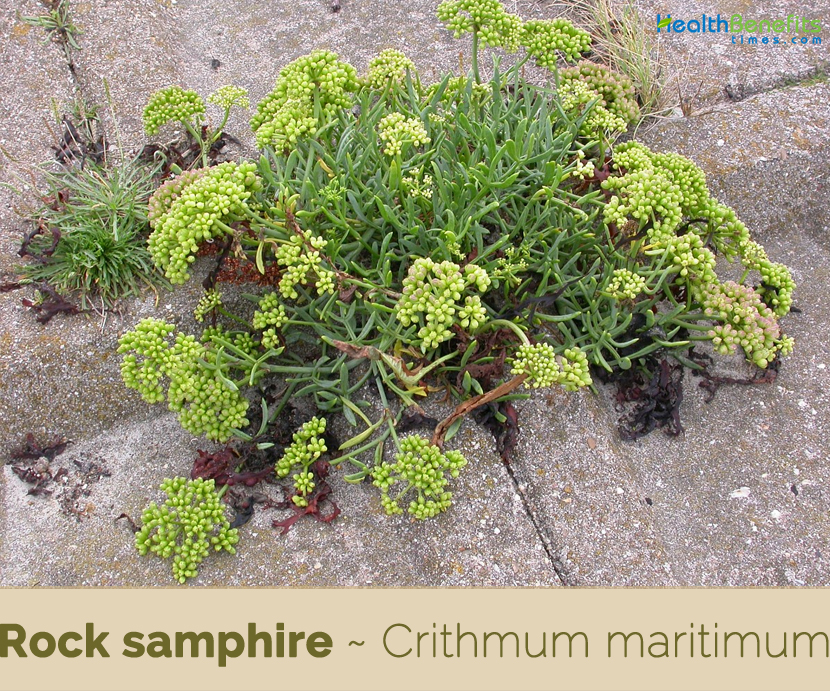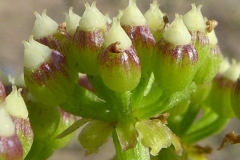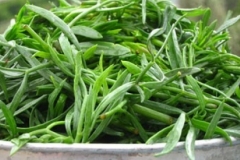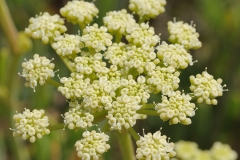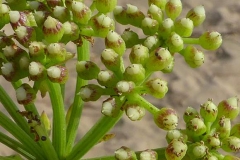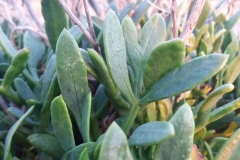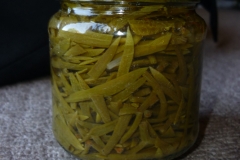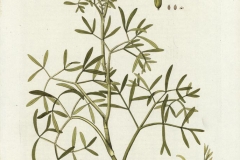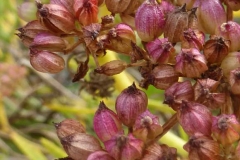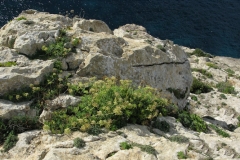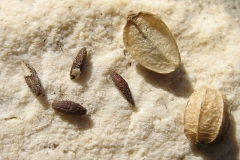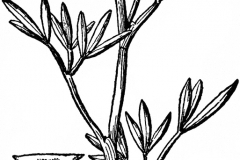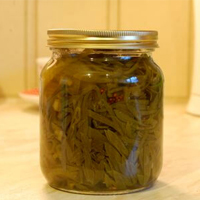The name “samphire” is derived from the French word “sampiere”, shortened version of “Saint Pierre”, which is a patron of fishermen. Name of the plant refers to the fact that this plant grows in the coastal areas. Rock samphire is also known as sea asparagus because it grows close to the sea and shares some morphological similarities with asparagus. This wonderful plant grows near sea shore and that is the reason it is called “sea vegetable “.
Plant description
Rock samphire is a salt tolerant hardy, succulent, smooth, much-branched perennial herb that grows about 10-30 cm tall. The plant is found growing on cliffs, rocks, or more rarely on sand, by the sea, rock crevices, and rocky shores and sometimes along shingle beaches. The plant grows best in sandy, well-drained soil. It prefers a moist light sandy or gravelly soil, doing very well between stones. Rock samphire is an edible wild plant. Plants are generally green but the color of flowers, seeds and fruits changes during the period of growth. This plant grows throughout the year and is considered as a perennial plant. Rock samphire has blue-green stems and leaves and yellow-green flowers. It is a salt tolerant hardy perennial plant.
Leaves are 1–2-pinnate, 3–7 cm long; segments fleshy linear-oblanceolate, sub-terete, 3–5 mm wide, margins entire; petiole to 5 cm long. Flowers are umbels compound with 8–36 rays; 3–6 cm diam., peduncles. Bracts are 5–8 mm long and entire. Sepal is minute. Petals are 1 mm long, yellow or yellow green. Flowering normally takes place from June to August. Fertile flowers are followed by ovoid-oblong, 5–6 mm long, yellowish or purple fruit, spongy when fresh; mericarp is triangular in cross-section. Carpophore is 5 mm long.
History
This species has a long history of use, both as a vegetable and as a medicinal plant, so it is possible to find lots of references. For instance, in the first century, both Dioscorides and Pliny the Elder referred to its consumption, eaten either raw or boiled, and also preserved in brine. Besides describing some other medicinal properties, they also agreed in the effectiveness as diuretic of a drink made with its seed, root, and leaves boiled in wine, especially to help frequent painful urination. Many other historical sources refer its use. Laguna (1555) mentioned that the preserved plant was brought to Spain from Sicily. Outside the Mediterranean region, the English Nicholas Culpeper describes the plant in his Complete Herbal (1653) as having a pleasant, hot and spicy taste and being a great “digestive”. The Spanish botanist Gómez-Ortega said that the part of Spain where the plant was more appreciated was Catalonia. There, the biggest sea fennel individuals were collected and prepared in vinegar to eat them, in salad or other several ways, all the year round, especially in winter.
Health Benefits of Rock Samphire
Let’s discuss the health benefits of this vegetable and improve our health;
1. Aids in Digestion
Rock samphire is a natural source of dietary fiber; rock samphire can do wonders for the body’s digestive system. Dietary fiber is able to bulk up the stool so that it can pass more easily through the digestive system without causing constipation or discomfort. Fiber help to reduce inflammation in the gut and guarantee that nutrient uptake is as efficient as possible.(1)
2. Improves Bone Health
Rock Samphire is a very rich source of calcium, which is one of the benefits of adding this sea vegetable to your diet. With a regular intake of calcium, you are also enhancing your body’s intake of iron, which is necessary for good circulation in the body. More importantly, the calcium intake will keep your bones strong and durable as you age. Bone mineral density naturally drops as we grow older, so increased levels of calcium are necessary to remain youthful and healthy.(2)
3. Antioxidant Properties
Fucoidans found in sea vegetables have antioxidant effects that make them very important for human health. Adding samphire to your body can help in a wide range of illnesses, ranging from skin conditions to cancer, as oxidative stress from free radicals comes in many forms. Fucoidans can help to neutralize that threat and keep your body protected from any would-be pathogens or external attacks.(3)
4. Regulates Sleep
Magnesium doesn’t get much credit in the mineral world, but it can have measurable effects on the hormone balance, neurotransmitter production, and general quality of life for many people. Rock Samphire happens to be very rich in magnesium and many people suffer from magnesium deficiency without even knowing. If you suffer from insomnia or regularly have restless nights, it could be a sign that your body’s natural rhythms are out of whack. Magnesium is ideal for rebalancing your circadian rhythms and giving you a good night’s sleep.(4)
5. Reduces Inflammation
There are many inflammatory conditions that can affect the body, ranging from arthritis and gout to hemorrhoids and infected wounds. Anti-inflammatory nature of samphire has made it a valuable herbal remedy, both when topically applied and consumed. It can help to ease pain and soothe swelling and inflammation, and even cause fevers to break.(5)
6. Boosts Immune System
Vitamin A and C are not only essential vitamins for processes throughout our body, but they also have a substantial effect on the immune system. Vitamin C stimulates the production of white blood cells, which are the first line of defense for the body. Additionally, both these vitamins function as antioxidants and are capable of neutralizing free radicals and stopping them before they can cause chronic diseases and oxidative stress.(6)
7. Weight Loss
Extremely low calorie and low-fat content of Rock samphire is good news for anyone who has been struggling to keep their diet in check. Additionally, the dietary fiber in samphire works to optimize excretion and nutrient intake. It helps in making you feel full, by suppressing the ghrelin hormone in the body. When combined, this can lead to less snacking, more energy, and a lower caloric intake to help you shed the pounds.(7)
8. Reduce the Risk of Cardiovascular Disease
Frequency of cardiovascular disease seems to be going up year after year, with a significant amount of new cases having been traced to a deficiency of dietary potassium. Potassium is known to counter the effects of excess sodium in order to normalize blood pressure by decreasing the tensions in the walls of blood vessels. Regular Rock samphire intake is one way to get enough potassium and it may help lower systolic blood pressure (especially in people with pre-existing high blood pressure), lower bad cholesterol level, regulate heartbeat and help keep cardiovascular diseases in check.
9. Enhance Muscle Contraction
Rock Samphire consists of sodium, an important nutrient that gives the muscles the ability to contract, even though we typically get sodium from a range of other foods. Dietary sodium in samphire assists nerve cells in sending electrical signals so that the muscles can contract hence, an absence of sodium will prevent the nerve cells from establishing a communication with muscle fibers. This may finally result in muscle twitching hence; a healthy diet should include samphire as it possibly can put an end to muscle weakness. That’s not to exclude the presence of potassium, which exerts a balancing effect on sodium and also promotes normal contractile processes of muscles and blood vessels
10. Defend the Body from Pathogens
White blood cells are the body’s first line of defense which stops harmful disease-causing invaders before they are able to cause infection. Rock Samphire has a good amount of Vitamin C which enhances the rapid production of white blood cells thus, safeguarding the body during flu season or when likely to be compromised.
11. Assist In Blood Circulation
Iron is important for metabolism and the production of red blood cells which further encourages growth and maintains health. Moderate amount of dietary iron in Rock samphire may assist iron in the transportation of oxygen from the lungs to the rest of the body and a reduction in the risk of diseases such as anemia.
12. Increase Beneficial Bacteria in the Gut
Beneficial bacteria play important roles in the digestion and absorption of food. Regular consumption of Rock samphire may be one of the best ways to boost beneficial bacteria naturally since it is rich in dietary fiber. Ensuring we consume enough of this dietary fiber helps ensures that these good bacteria are constantly nourished, allowing them to neutralize any damage from harmful microbes and improve the performance of the immune system. These bacteria may also increase the digestion of food and prevent conditions that allow for growth of harmful bacteria.
13 Promote Repair of Worn Out Tissues
Recovery from tissue damage is more of a repair process than a regenerative one and so, to efficiently recover from damage to the cells, the human body utilizes proteins. Protein is accountable for the building and repair of structures that may have undergone one form of damage or the other. Dietary protein in samphire may be able to build and maintain muscle, burn calories and improve satiety. Since protein is utilized in many vital processes, it is significant that it should constantly be replaced, thus, eating Rock samphire may help refill any lost protein in the body, even though its overall amount may be small, every little bit helps.
14. Slow the Aging Process and Brighten Skin
Vitamin C is a natural forager of free radicals that actively cause cellular damage. Vitamin C in Rock samphire may slow the ageing process in two ways. First, it possibly reduces the defined lines that form when there is a reduction in the level of collagen production by the body. It does this by increasing collagen production so the elasticity of the skin is restored and it is able to bounce back to its original form when stretched. Secondly, Vitamin C decreases the size of large pores on the skin, having a natural astringent property on skin.
https://www.youtube.com/watch?v=8Ze_bo9QsAs
Traditional uses and benefits of Rock Samphire
- Rock samphire is little used in herbal medicine, though it is a good diuretic and holds out potential as a treatment for obesity.
- It has a high vitamin C and mineral content and is thought to relieve flatulence and to act as a digestive remedy.
- Young growing tips are carminative, depurative, digestive and diuretic.
- Leaves have the reputation for helping people lose weight and so are used in treating cases of obesity as well kidney complaints and sluggishness.
- It is a good diuretic and holds out potential as a treatment for obesity.
- It has a high vitamin C and mineral content and is thought to relieve flatulence and to act as a digestive remedy.
- Strong extract made from the plant has been used traditionally as an herbal remedy for intestinal worms.
- Due to the plant’s high levels of vitamin C, it was once in much demand as a treatment for scurvy.
- Both vitamin C and the flavonoids have antioxidant properties and contribute to the anti-inflammatory and diuretic effect of the herb.
- Essential oil in the herb is also thought to be good for the digestive system.
- It may be helpful in reducing intestinal gas production in the same manner as fennel.
- Leaves of the plant have a reputation of being helpful for losing weight and to treat obesity.
- Extract from the plant is used to regenerate wrinkles, help deal with brown spots, and provide shine and improved skin tone in cosmetic and creams.
Culinary Uses
- Leaves can be consumed raw or cooked.
- Leaves are used as a flavoring in salads etc.
- Gathered in spring, the young leaves when sprinkled with salt and boiled make a very good pickle.
- Leaves are rich in vitamin C.
- Seed pods are used to make a warm aromatic pickle.
- Stems, leaves and seed pods may be pickled in hot, salted, spiced vinegar, or the leaves used fresh in salads.
- Plant is considered particularly suitable for many fish and seafood dishes.
- Succulent leaves and stalks of rock samphire can be boiled or steamed and eaten in the same manner as asparagus.
- Highly aromatic and salty leaves can also be used fresh in salads. Furthermore, the young leaves, stems, and seeds can be used in pickle making.
- The tender leaves and stems, collected both in spring and summer, and even in autumn, have been traditionally consumed as a salad vegetable in most Mediterranean countries, such as Spain, Italy, Slovenia,Croatia, Bosnia-Herzegovina, Greece, Cyprus, Turkey, Tunisia, and Morocco.
- Although it can be eaten raw, it is frequently scalded in boiling water to soften, before using in salads.
- Tender leaves and stems have been traditionally preserved as pickles or brines throughout the Mediterranean region.
- In Cyprus, it is eaten like an appetizer with several kinds of food in the Balearic Islands; they are typically eaten with bread and olive oil, or prepared with capers.
- It is also used as a cooked vegetable, usually mixed with other species, so it can be also considered as a condiment, depending on the proportions of use.
- It is sold included in wild vegetable mixes, in the markets of Dalmatia, Croatia, and in Menorca, Spain, where it is cooked with rice.
- As a condiment, it has been used for seasoning olives, together with other aromatic plants, such as thyme and oregano in Catalonia, Spain, and also for homemade anchovies in brine, being covered with the leaves of the plant that confer them an special scent.
- In Italy, the plant is used for the elaboration of sauces, or as a fish condiment, being also employed in modern cuisine.
- Besides the leaves, the seeds are also used as a condiment, in Sicily.
- In Mallorca, Spain, some people used this plant, instead of fennel in the elaboration of the typical herb liqueur.
- Nowadays, some supermarkets sell jars with the pickled leaves.
Dosage and Administration
Very limited information is available on the dosages or the doses of the herb as herbal medicine. It is advisable to contact a knowledgeable herbalist prior to use or self-medication.
For commercial products containing the herb in any form, the manufacturer’s instructions should be followed.
Other facts
- An essential oil from the plant is used in perfumery.
- Whole plant is aromatic and has a powerful scent.
- Use of Samphire as a condiment and pickle, or as an ingredient in a salad is of ancient date.
- It used at one time to be cried in London streets as ‘Crest Marine.’
- In some seaside districts where Samphire is found, it is still eaten pickled by country people.
- In the past, rock samphire was consumed by sailors to protect them against scurvy.
- When cooking with samphire, there is no need for more salt to be added, as the vegetable is more than enough to flavor the food.
- Flowers produce pleasant, sweet odor which attracts various insects that play important role in the pollination of this plant.
- Rock Samphire is even stated in one of the best-known Shakespeare’s pieces – “King Lire”.
Pickled Rock Samphire Recipe
Ingredients
- 500 g rock samphire
- 5 echalion shallots
- 500 ml white wine vinegar
- 450g granulated sugar
- 1/4 tsp ground cloves
- 1 tbsp black mustard seeds
- 1 tsp ground mace
Instructions
- Remove Rock Samphire leaflets from main stems, and thinly slice the echalion shallots.
- Put the leaflets and shallots in cold salted water for 30 minutes. Make sure they are submerged.
- Put Rock Samphire and shallots in a saucepan and cover with water, then bring to the boil and simmer for 5 minutes. Strain and cool. The spoon into sterilized jam jars.
- Now put white wine vinegar, sugar and spices into a saucepan and stir over a medium heat until sugar has completely dissolved. Pour into jars and cap.
- Leave for at minimum a month, and preferably three. However one jar of mine didn’t last 24 hours and still tasted fantastic.
Precautions
- The herb should not be consumed in large amounts during pregnancy.
- Rock samphire consists of furocoumarins that can make some people more sensitive to sunlight (UV light) and causing a reaction known as phyto-photo dermatitis.
- Phyto photo-dermatitis appears only where the skin has been exposed to sunlight, usually within hours after exposure.
- You should never use rock samphire essential oil internally and should dilute it with carrier oil before applying it topically.
- People who already suffer from high blood pressure or are at high risk for cardiovascular diseases, samphire should be eaten with caution.
References:
https://davesgarden.com/guides/pf/go/2793/
https://npgsweb.ars-grin.gov/gringlobal/taxonomydetail.aspx?id=402237
https://pfaf.org/user/Plant.aspx?LatinName=crithmum+maritimum
http://www.floracatalana.net/crithmum-maritimum-l-
https://botanical.com/botanical/mgmh/s/samphi10.html
https://en.wikipedia.org/wiki/Crithmum
Comments
| Rock samphire Quick Facts | |
|---|---|
| Name: | Rock samphire |
| Scientific Name: | Crithmum maritimum |
| Origin | Southern and western coasts of Britain and Ireland, on Mediterranean and western coasts of Europe including the Canary Islands, North Africa and the Black Sea |
| Colors | Yellowish or purple |
| Shapes | Ovoid-oblong, 5–6 mm long, yellowish or purple, spongy when fresh |
| Calories | 30 Kcal./cup |
| Major nutrients | Vitamin C (43.33%) Manganese (43.04%) Sodium (30.93%) Iron (28.63%) Calcium (22.40%) |
| Health benefits | Aids in Digestion, Improves Bone Health, Healthy Bones, Regulates Sleep, Enhance Muscle Contraction, Repair Worn Out Tissues, Assist In Blood Circulation, Reduces Inflammation, Reduce the Risk of Cardiovascular Disease, Boosts Immune System, Weight Loss, Slow Aging Process and Brighten Skin |
| Name | Rock Samphire |
|---|---|
| Scientific Name | Crithmum maritimum |
| Native | Southern and western coasts of Britain and Ireland, on Mediterranean and western coasts of Europe including the Canary Islands, North Africa and the Black Sea |
| Common Names | Rock samphire, Samphire, Sea-fennel, Crest Marine, Sampier, True samphire, sea samphire, rock fennel, crest marine, Stone Samphire |
| Name in Other Languages | Catalan: Fonoll marí Danish: Søfennikel Dutch: Zeevenkel English: Rock samphire, Samphire, Sea-fennel, Crest Marine, Sampier, True samphire, sea samphire, rock fennel, crest marine, Stone Samphire Estonian: Randköömen French: Fenouil marin, Criste-marine, fenouil de mer Galician: Pirixel de mar German: Meerfenchel Hebrew: קריתמון ימי Italian: Herba di San Pietra, Sanpetra Nynorsk, Norwegian: Sanktpeterskjerm Occitan: Fenolh de mar Portuguese: Funcho-do-mar, Funcho-marítimo Scottish Gaelic: Craobhraic, Géirgín Spanish: Hinojo marino, Cenojo de mar, Perejil de mar Swedish: Saltmärke, Strandsilja Ukrainian: Krytmiy morsʹkyy (Критмій морський) Welsh: Corn-carw’r môr Western Frysian: Seefinkel |
| Plant Growth Habit | Salt tolerant hardy, succulent, smooth, much-branched perennial herb |
| Growing Climates | On cliffs, rocks, or more rarely on sand, by the sea, rock crevices, rocky shores and sometimes along shingle beaches |
| Soil | Grows best in sandy, well-drained soil. Prefers a moist light sandy or gravelly soil, doing very well between stones |
| Plant Size | 10-30 cm in height |
| Leaf | 1–2-pinnate, 3–7 cm long; segments fleshy linear-oblanceolate, sub-terete, 3–5 mm wide, margins entire; petiole to 5 cm long |
| Flowering season | June to August |
| Flower | Umbels compound with 8–36 rays; 3–6 cm diam., peduncles; bracts 5–8 mm long, entire. Sepal is minute. Petals c. 1 mm long, yellow or yellow green |
| Fruit Shape & Size | Ovoid-oblong, 5–6 mm long, yellowish or purple, spongy when fresh; mericarps triangular in cross-section. Carpophore c. 5 mm long. It has spongy outer coat and single, barley-like seed inside |
| Fruit Color | Yellowish or purple |
| Seed | 3-5 mm long, ovoid or oblong, yellowish to purple and with ribs |
| Pollination | Self-fertile or by insects |
| Propagation | By seeds and division |
| Plant Parts Used | Above ground parts of the plant |
| Season | August to October |
| Lifespan | More than 2 years |
| Major nutritions | Vitamin C (Ascorbic acid) 39 mg (43.33%) Manganese, Mn 0.99 mg (43.04%) Sodium, Na 464 mg (30.93%) Iron, Fe 2.29 mg (28.63%) Calcium, Ca 224 mg (22.40%) Magnesium, Mg 76.6 mg (18.24%) Copper, Cu 0.12 mg (13.33%) Total dietary Fiber 4.68 g (12.32%) Zinc, Zn 0.665 mg (6.05%) Potassium, K 252 mg (5.36%) |
| Health Benefits |
|


